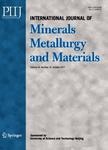Effects of Br^- and I^- concentrations on Zn electrodeposition from ammoniacal electrolytes
Effects of Br^- and I^- concentrations on Zn electrodeposition from ammoniacal electrolytes作者机构:School of Metallurgy and Environment Central South University School of Metallurgical Engineering Hunan University of Technology
出 版 物:《International Journal of Minerals,Metallurgy and Materials》 (矿物冶金与材料学报(英文版))
年 卷 期:2015年第22卷第7期
页 面:682-687页
核心收录:
基 金:supported by the National Basic Research Program of China (No. 2014CB643404) the National Natural Science Foundation of China (Nos. 51274094 and 51374254)
主 题:zinc electrodeposition bromide iodide ammonium chloride current efficiency energy consumption
摘 要:The effects of Br- and I- concentrations on the cell voltage, anodic polarization, current efficiency (CE), and energy consumption (EC) of zinc electrodeposition from ammoniacal ammonium chloride solutions were investigated. The surface morphology of zinc deposits was also examined. Scanning electron microscopy (SEM) and X-ray diffraction (XRD) were used to characterize the morphology of zinc deposits and the phase of anodic sediments produced during electrolysis. The results clearly showed that the CE slightly increased from approximately 95.12% in the absence of F and Br- to 97.08% in the presence of 10 g·L-1 Br; in contrast, the CE significantly decreased to less than 83% in the presence of 10 g·L-1 I- . The addition of Br and I- positively affected the EC, which decreased from 2514 kW·h·t-1 to approximately 2300 kW·h·t-1. The results of anodic polarization measurements showed that the voltage drops were 130 and 510 mV when the concentrations of Br- and I- were 10 g·L-1 at a eUlTent density of 400 A·m2, respectively. SEM images showed that the addition of Br- and I- caused different crystal growth mechanisms, which resulted in the production of compact and smooth zinc deposits. The anodic reactions of I were also studied.



